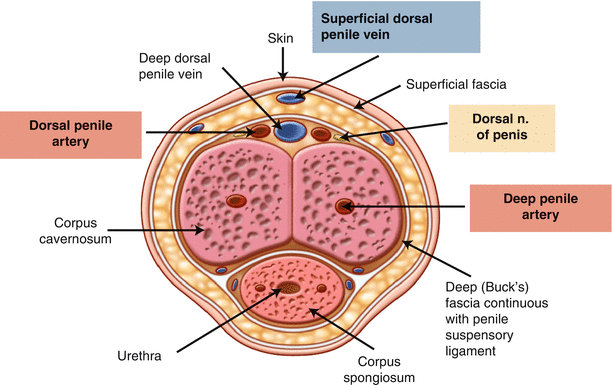Background:
Named after the Greek god of fertility, Priapus, priapism is defined as an erection that lasts for longer than 4 hours that is not associated with sexual stimulation. Why do we care? Because 90% of men with persistent erections > 24 hours will have permanent erectile dysfunction. There are three types: non-ischemic, ischemic, and recurrent.
Non-Ischemic ("high flow"):
The less common type, this is due to an excess of blood via a fistula between the cavernosal artery and the corpus cavernosum, usually in the setting of trauma.
Ischemic ("low flow"):
The more common type, this is due to obstruction of venous outflow as a result of impaired relaxation of cavernosal smooth muscle. This is a urological emergency.
Recurrent ("stuttering"):
A form of ischemic priapism that occurs in men with sickle cell disease. It's characterized by initially short erections that progressively worsen.
Workup:
History should include: duration of current erection, prior episodes, any medications used (legal or otherwise), history of hematological disorders (specifically sickle cell), history of trauma, how severe the pain is.
Your entire workup is used to distinguish between ischemic and non-ischemic priapism. The table below summarizes the characteristics.
Treatment:
Call urology!! (if available)
If unavailable, believe it or not, high flow or non-ischemic priapism, can resolve spontaneously, actually does not require treatment, and can be managed as an outpatient by urology.
First of all, analgesia should be provided. An easy way to do this is to perform a dorsal penile nerve block.
Steps:
Obtain consent, grab your materials (lidocaine), syringe, needle, alcohol/iodine, cleanse the area
Insert a small needle at the 2 o'clock and 10 o'clock position at the base of the penis
Feel for the pop of scarpa's (superficial) fascia
Aspirate and inject 2mL anesthesia in each position
This can also be done under ultrasound guidance!
Second, the American Urological Association recommends primary aspiration of cavernosal blood. To do this, insert an 18 gauge needle to the lateral aspect of the penis one in each corporal body. 30-60ccs of blood should be removed.
If this is sufficient, stop here. If tumescence persists, phenylephrine injection may be attempted. This should be given in 1mL aliquots of a 100-500mcg/mL concentration. To mix this, take a vial of phenylephrine (10mg/mL) and take out 1mL, mix this in a 100mL bag of NS. To make it easier, don't take the needle out of the penis and simply attach a syringe with the medication to the needle. This may be repeated every 3-5 minutes for an hour until resolution.
Fun fact: epinephrine can be used as well based on several case series. The dosing: 2mL of a 1:100,000 (10mcg/mL) concentration. This is essentially your push-dose dose (ie. 1mL of code cart epi in 9mL NS)
If this fails, the patient will need urological surgery... won't bore you with the details here!
What about sickle cell disease?
Priapism in sickle cell disease should be managed in the same way as ischemic priapism. It is rare that standard therapies do not work, but if they do not, exchange transfusion or simple transfusion can be considered. Don't forget to get a retic level in these patients!
TL;DR
Ischemic priapism is painful and is a urological emergency
Call urology consult!
Provide analgesia/perform a dorsal nerve block
Aspirate with two needles laterally
Phenylephrine if this fails
Further management with urology if this fails
Consider exchange transfusion in patients with sickle cell disease with priapism that doesn't resolve with these measures
Sources:
https://www.uptodate.com/contents/priapism
http://www.emdocs.net/priapism-ed-pearls-pitfalls/
http://www.nuemblog.com/blog/priapism
https://www.uptodate.com/contents/priapism-and-erectile-dysfunction-in-sickle-cell-disease
https://www.asra.com/asra-news/article/151/peripheral-nerve-blocks-for-urologic-pro
https://www.ncbi.nlm.nih.gov/books/NBK535389/
https://www.ncbi.nlm.nih.gov/pubmed/11416834






